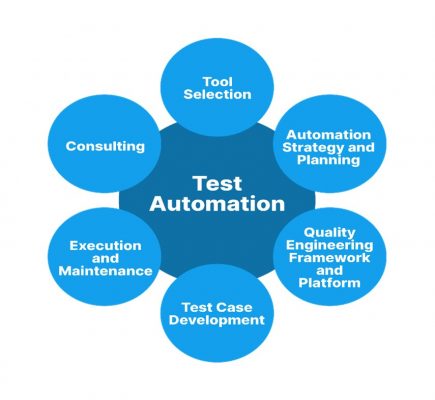Purpose of the article: The purpose of the document is to provide a comprehensive guide on Evolution of Test Automation tools in terms of features, flexibility, test stability and scalability. It describes how each generation expanded the possibility of what we can do better with test automation to do more effective software testing.
Intended Audience: Automation Engineers /QA Managers/ QA Director/QA Organizations
Tools and Technology: Selenium, AccelQ, Ranorex, TestComplete & Katalon
Keywords: Test Automation, Data Driven Automation, Keyword Driver Automation & AI Driven Automation
What is Test Automation?
Test automation involves employing software tools rather than humans to execute test cases efficiently and consistently, ensuring repeatability in testing processes. The automation software tools will oversee the tests during test automation, compare the execution outcome to the expected outcome, and report the results.

History of Test Automation:
Test automation has evolved over the years, becoming progressively simpler and more sophisticated. Its inception dates back to the 1970s, with IBM’s Automated Test Mastermind System marking an early real-world application. The evolution of test automation can be categorized into four distinct stages, each featuring unique testing tools and practices. The four stages are:
- Record-and-playback tools
- Script-based tools
- Framework-based tools
- AI/ML-based tools

Record and Playback Tools:
In the 1980s and 1990s, record-and-playback tools emerged as pioneering solutions for test automation. These technologies empowered testers to script and replay their interactions with software programs, enabling the automation of repetitive testing tasks through script execution.
Poor documentation of scripts made maintenance nearly impossible, necessitating inclusion of both steps and data within the test to prevent disruption from minor application changes. Example: Mercury QuickTest, IBM Rational Robot.
Script-based Tools:
Scripting forms the foundation of traditional test automation. During the 1990s and 2000s, script-based tools gained prominence as versatile alternatives to record-and-playback tools. These technologies empowered testers to craft programming scripts for automating testing procedures, granting them greater autonomy and control. Proficiency in scripting languages, supported by automation technologies, is crucial for the test team to effectively utilize scripting capabilities. Automation teams were fairly at ease with creating driver scripts, adding logic to process data, handling timing synchronization, handling errors, recovering from errors, and recording and reporting results.
Mercury QuickTest Professional (QTP) and Selenium are the leading script-based test automation tools renowned for their versatility and efficiency in software testing. QuickTest Professional, developed by Mercury Interactive (later acquired by HP), emerged in the early 2000s as a powerful solution for automated functional testing. Its user-friendly interface and support for various scripting languages made it popular among testers worldwide. On the other hand, Selenium, an open-source project initially developed by Jason Huggins in 2004, gained prominence for its robust web testing capabilities and cross-browser compatibility. Over time, Selenium evolved into a comprehensive suite comprising Selenium IDE, WebDriver, and Grid, offering extensive support for web application testing.
Framework-based Tools:
These tools offered complete testing framework, encompassing libraries, functions, and methodologies for creating and overseeing test automation scripts. Framework-based tools offer structured and systematized approach to test automation, providing flexibility and efficiency in building, execution, and maintenance of test scripts across various software applications and scenarios.
Released in 2004, TestNG became a popular Java-based testing framework, offering test configuration, data parameterization, test grouping, and advanced reporting features like detailed HTML reports and result analysis.
Released in 2008, Cucumber caters to behaviour-driven development (BDD) by furnishing a testing framework for defining, executing, and reporting on BDD tests.
Codeless Tools:
Codeless test automation tools, as the name suggests, allow users to create and execute automated tests without the need for writing extensive code. These tools typically offer intuitive graphical user interfaces (GUIs) and drag-and-drop functionalities that enable users to design test cases by assembling pre-built components or by recording interactions with the application under test.
Worksoft, Tosca, Katalon, and other codeless automation tools transform testing by offering intuitive platforms that streamline test automation without the need for extensive coding.
AI/ML-based Tools:
AI-driven testing systems leverage machine learning techniques to overcome limitations, resulting in more dependable and stable tools like AccelQ and TestIM. These tools can adapt to environment or application changes, while their user-friendly interfaces enable non-technical stakeholders to participate, enhancing the effectiveness and efficiency of testing procedures.
Test automation has evolved significantly with AI/ML-based solutions, which revolutionize testing with smarter and more efficient methods. By automating testing tasks and leveraging technologies like Machine Learning and Natural Language Processing, these solutions enhance test accuracy and reduce manual effort, marking a significant advancement in testing capabilities.
Conclusion:
To sum up, the evolution of test automation is a tale of continuous development and adjustment. From the inception of record-and-playback tools to the latest AI/ML-based tools, each phase has broadened the potential of test automation, resulting in more efficient, reliable software testing. While the future of test automation is still unfolding, it is evident that it will remain a crucial tool for enhancing the quality and reliability of software operations.
Author Bio:

Madhu Kumar Dakara
IQE - Team Lead
IT Professional with 7+ years of experience in QA & Automation testing. Have good experience in Software Testing including Manual Testing, API Testing, Web, Mobile and API Automation in different domains like Enterprise Learning Management System (ELMS), E-Commerce, Healthcare, and Enterprise Resource Planning (ERP). Experience in wide range of automation testing tools like Selenium Web driver, Rest Assured, Appium, POSTMAN, TestComplete. Expertise in TestNG framework, Cucumber framework, Keyword, Data driven Frameworks, Hybrid frameworks.


